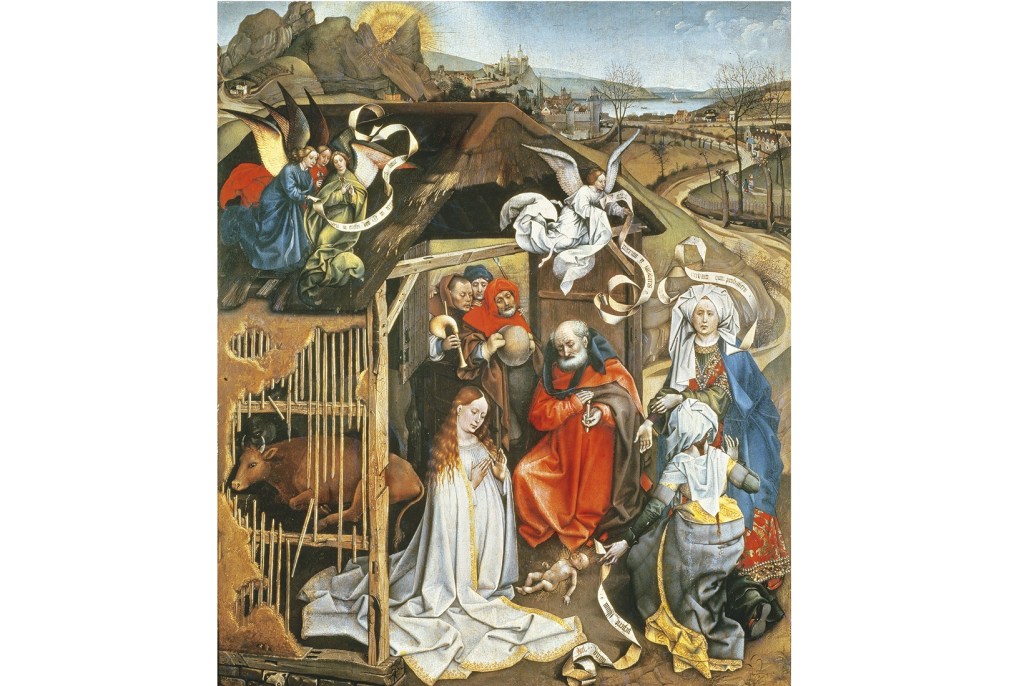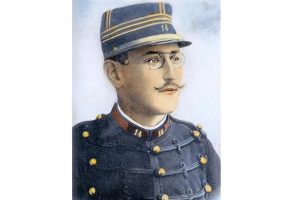There are many marvelous things to be seen in the Musée des Beaux-Arts at Dijon. But when I paid a visit a couple of years ago (in those days you could just step on a train and do such things), it was a little picture of the Nativity that particularly caught my eye. Its date, artist and original owner are all uncertain, but its beauty and originality were clear at a glance. Here, for almost the first time in European art, the appearance of ordinary things and people were the subject of close, rapt observation.
Not of course that there was anything ordinary about the Nativity itself, which was a miraculous, world-changing event — signaled in the painting by the bright golden sun rising over distant jagged hills. This marvel involved both worldly and supernatural elements so, accordingly, the image was painted with different levels of verisimilitude.
The fluttering angels are not naturalistic at all, appropriately since they are spiritual beings. The holy family are more so, while the three shepherds peering through a window in the stable wall could be portraits of real 15th-century farmhands — especially the one on the left who is holding the bag-pipe.
Even more amazingly convincing is the landscape behind: a stretch of medieval Europe in which you can go for a virtual walk, back down the road the holy family must have taken, past the pollarded trees, across the bridge into the little walled town of Bethlehem, over the pass beyond, on and on.
That vista, in movie terms, is a long-shot, but there are also astonishing close-ups. The wattle and daub of the stable has flaked away to reveal a snugly curled-up cow. What really struck me, though, was the post holding up the nearside of the structure. This is an exact portrait of a specific piece of battered, reused timber. Every knothole, insect tunnel, split, roughly carpentered joint and variation in the grain of the wood is represented with close-focus precision. Beneath, the footing of the wall has been studied with the same fascination, especially a single, knobbly flint.
Why go to such extraordinary pains to depict these humble objects? The post could be a reference to the cross that awaits the baby Jesus. But the artist also seems to be in love with the idea of portraying the realities of the medieval world: how a wicker fence was woven, and the precise look of a thatched roof. Who was that brilliant person? Well, although there is a prime suspect, the case is still not altogether solved.
Traditionally, Christmas is a time for parlor games and detective stories. The history of art contains many of those, but none more intriguing — or mystifying — than the case of the Master of Flémalle, first investigated in the 1840s and still not fully solved.
It began when a curator and artist named Johann David Passavant bought three striking and very old pictures for the Städel Museum in Frankfurt. He got them from a Flemish textile merchant living in Aachen who claimed that they had originally come from a monastery at Flémalle, a little place on the outskirts of Liège.
Since they were neither signed nor dated, they were attributed to an anonymous ‘Master of Flémalle’ (dreaming up such hypothetical artistic personalities was a popular pastime among 19th-century scholars). Embarrassingly, it subsequently emerged that for some reason the seller had been telling a fib and there never had been a monastery at Flémalle. But the name stuck because it was so useful.
By and by more pictures were assigned to this shadowy master, including the Dijon Nativity. By the 20th century there was a sizable roster of works, none signed or dated, which were attributed to the mysterious master (the exact list is debated to this day). Meanwhile, scholars burrowing in the archives had discovered a prominent painter living in the town of Tournai who, according to documents, had produced many paintings — none of which unfortunately were known to have survived.
His name was Robert Campin. Among his known pupils were Jacques Daret and the great Rogier van der Weyden, both of whose works showed strong resemblances to the ‘Master of Flémalle’ group. So it seems very likely, though not quite certain, that Campin and the mysterious master were one and the same.
Among the wad of information concerning Campin’s financial and business affairs are a few colorful items. Notably, on July 30, 1432, when the painter was in his mid-fifties, he was accused of living a dissolute and adulterous life with a woman named Laurence Polette despite the fact that he had long been married. Campin was sentenced to a year’s banishment. But in October his sentence was overturned after an intervention from a local aristocrat, Margaret of Burgundy.
This snippet of information brought out the Hercule Poirot in me.
No one knows the history of the Dijon Nativity before the museum bought it from a local collector in the early 19th century. But from its size and its endless savorable detail, it looks like a picture for a private patron: a devout connoisseur. Margaret, living at the castle Le Quesnoy some 20 miles away from Tournai, was ideally placed to be a customer of Campin’s.
[special_offer]
If so, it might explain an unusual aspect of the picture: the presence of two midwives. These, the richly dressed women on the right, do not feature in the gospels, but they were popular figures in mystery plays and religious storybooks. Allegedly, one, named Salome, doubted the virgin birth. The text swirling around her head in the Dijon picture — the 15th-century equivalent of a speech bubble — reads: ‘I believe it only when I have proved it.’ She was instantly punished for this aspersion by the withering of a hand (the one she is holding out). But at this point an angel appeared, proclaiming: ‘Touch the boy and you will be cured.’ Azel, the other, more pious midwife kneels in wonder.
Now, the questions of birth and legitimacy were on the minds of Margaret and —particularly — her daughter Jacqueline who had recently dissolved her marriage to the Duke of Brabant, wed instead Humphrey, Duke of Gloucester, then quickly fallen pregnant. Many thought this second marriage, carried out in haste (and in Essex), was invalid; the Pope declared it so in 1425, a few years before the probable date of the Nativity. It is easy to imagine Margaret and Jacqueline nodding with approval at the fate of the doubting midwife.
Well, that’s my theory anyway. And, like most speculation about Campin, it is unlikely to be proved any time soon. Experts continue happily to divide the possibly-by-Campin pictures into piles labeled ‘workshop of’, ‘follower of’, and so on. Since he evidently ran a picture-painting business on a light-industrial scale, it is an open question whether the master himself or his assistants was actually responsible for a particular work. There are other apprentices mentioned in the files: one Haquin de Blandain, for example, and a certain Willemet. Perhaps one of those painted the wonderful Nativity in Dijon. Fortunately, for those who enjoy a puzzle, it is unlikely we will ever find out.
This article was originally published in The Spectator’s UK magazine. Subscribe to the US edition here.


















